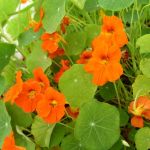| Common Name: |
Garden Nasturtium |
| Other Names: |
Indian Cress |
| Botanical Name: |
Tropaeolum majus |
| Genus: |
Tropaeolum |
| Family: |
Tropaeolaceae |
| Location: |
S America (Columbia to Bolivia) |
| Cultivation: |
Well-drained, moist, average to poor soil in sun. Self-seeds freely in some gardens and may be invasive. Rich soil, promotes leaf growth at the expense of flowers. Often used in companion planting to deter cucumber beetles and whitefly bit is susceptible to aphids, especially blackfly. Nasturtiums are reputed to deter woolly aphifs if plants are grown at the base of apple trees. Prone to viral diseases. Overwinter sterile cultivars in sunny, frost-free conditions. |
| Propagation: |
By seed sown in early spring at 13-16°C (55-61°F); by basal cutting or stem-tip. |
| Harvest: |
All parts are picked in summer and used fresh for infusions and tinctures. Plants are also cut for juice extraction. |
| Height: |
3m (10ft) |
| Width: |
1.5-2m (5-6ft) |
| Variations: |
Alaska
Is dwarf and bushy, with leaves that are irregularly marbled with creamy-white, and yellow, cream, red, orange-red, and mahogany flowers.
Height: 30cm (12in)
Width: 45cm (18in) |
Empress of India
Is dwarf and bushy, with purple-green leaves and scented, semi-double, crimson flowers. Dates back to the 19th century.
Height: 30cm (12in)
Width: 45cm (18in) |
Hemine Grashoff
Is another 19th century cultivar. It bears double orange-scarlet flowers and is sterile.
Height: 20cm (8in)
Width: 45-60cm (18-24in) |
Peach Melba
Is compact and floriferous with creamy yellow, single flowers, blotched with scarlet in the throat.
Height: 23-30cm (9-12in)
Width: 45cm (18in) |
Whirlybird Series
Is dwarf and compact, with single to semi-double, spur-less, upward facing blooms, borne well above the foliage, in cream, orange, salmon, yellow, mahogany, scarlet and cherry red. Produces clean flowers for culinary purposes.
Height: 24cm (10in)
Width: 35cm (14in) |
|
| Hardiness: |
Half-hardy to tender. Min. 3°C (37°F) |
| Parts Used: |
Whole plant, Leaves, Flowers, Buds, Fruits. |
| Properties: |
A bitter, antiseptic, tonic herb that has diuretic and expectorant effects, and controls fungal and bacterial infections. |
| Medicinal Uses: |
Internally for genito-urinary and respiratory infections, scurvy, and poor skin and hair conditions. Externally for baldness, minor injuries, and skin eruptions. |
| Culinary Uses: |
Leaves, flowers, flower buds, nectar spurs are eaten in salads and sandwiches. Chopped fresh leaves give a peppery flavor to soft cheese or egg dishes. Flowers are used to make nasturtium vinegar. Unripe fruits are pickled as a substitute for capers. Ripe seeds are roasted and ground as a seasoning. |
| Economic Uses: |
Combined with Buxus sempervirens (See, Common Boxwood), Quercus robur (See, English Oak) and Urtica dioica (See, Nettle) in hair lotion. |
| Bibliography: |
Encylopedia of Herbs by Deni Brown Copyright ©: 1995, 2001 Dorling Kindersley Limited pp.394-395
|
